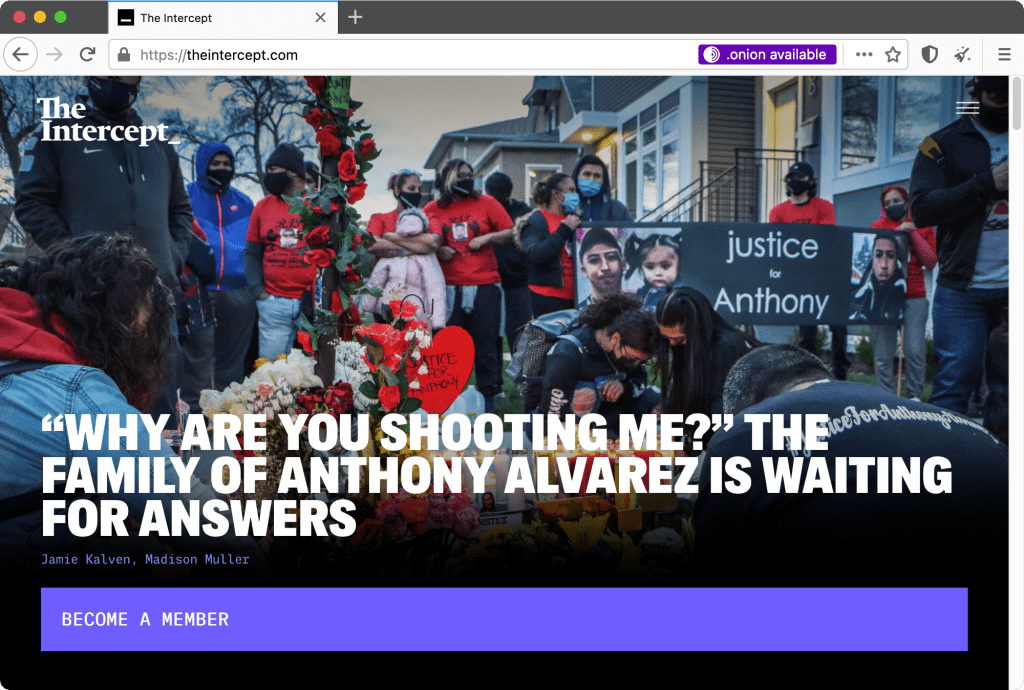Tor, the decentralized anonymity network, has been an integral part of our workflows at The Intercept since we launched in 2013. We use Tor to securely communicate with confidential sources using our SecureDrop server, and individual journalists routinely use Tor Browser to covertly investigate companies and powerful people.
Now, there’s a new way for readers of The Intercept to browse this website more securely and anonymously over the Tor network. Just open up Tor Browser and navigate to our new Tor onion service at https://27m3p2uv7igmj6kvd4ql3cct5h3sdwrsajovkkndeufumzyfhlfev4qd.onion/. You can also get there by loading theintercept.com in Tor Browser and clicking the “.onion available” button in the address bar.

Tor Browser users can click the “.onion available” button in the address bar to get to the onion service.
Websites that end in “.onion” are known as Tor onion services — or if you want to be dramatic about it, the “dark web.” Here’s how it all works.
Tor Browser Lets People Browse the Web Anonymously
When you load a website in a normal web browser like Chrome, Firefox, Safari, or Edge, you make a connection over the internet directly from your house (or wherever you happen to be) to the web server you’re loading. The website can see where you are coming from (and track you), and your internet service provider can see which website you’re loading (and track what you’re doing and sell advertising based on your activity).
But if you open Tor Browser and load the same website, none of those parties can spy on you. Even Tor itself won’t know what you’re up to. Within the network, consisting of thousands of nodes run by volunteers across the internet, you do not connect from your house directly to the web server. Instead, your connection first bounces between three Tor nodes and then finally exits the Tor network and goes to the website. The website can’t see where you’re coming from, only that you’re using Tor. Your ISP can’t see what website you’re visiting, only that you’re using Tor. And the Tor nodes themselves can’t fully track you either. The first node can see your home IP address, because you connect directly to it, but can’t see what site you’re loading, and the last node (also called the exit node) can see what site you’re loading but doesn’t know your IP address.
In short, Tor Browser makes it so people can load websites anonymously. Tor onion services do the same thing, except for websites themselves.
Tor Onion Services Let Websites Themselves Be Anonymous
So what exactly is an onion service? Just like when people use Tor Browser to be anonymous, web servers can use Tor to host anonymous websites as well. Instead of using normal domain names, these websites end with “.onion”.
If you load an onion site in Tor Browser, both you and the web server bounce encrypted data packets through the Tor network until you complete an anonymous connection, and no one can track anyone involved: Your ISP can only see that you’re using Tor, and the website’s ISP can only see that it’s using Tor. You can’t learn the website’s real IP address, and the website can’t learn yours either. And the Tor nodes themselves can’t spy on anything. All they can see is that two IP addresses are both using Tor.
Onion services have another cool property: The connection never exits the Tor network, so there are no exit nodes involved. All the communication between Tor Browser and the web server happens in the dark.
The Most Popular Site on the Dark Web
When people hear about the “dark web,” they tend to think about shady things like drug markets and money laundering. That stuff is, in fact, facilitated by anonymous websites running Tor onion services, just as it’s facilitated by the normal, non-anonymous internet. But it’s not the only use of onion services by a long shot.
The Intercept along with dozens of other newsrooms around the world, including pretty much every major news organization, run Tor onion sites for SecureDrop, a whistleblower submission platform. With The Intercept’s new onion service for readers of our website, we’ll also join the ranks of the New York Times, ProPublica, BuzzFeed News, The Markup, and other news organizations in making their core websites available as onion services.
I also develop an open source tool called OnionShare which makes it simple for anyone to use onion services to share files, set up an anonymous drop box, host a simple website, or launch a temporary chat room.
But, by far, the most popular website on the dark web is Facebook. Yup, Facebook has an onion service. For when you want some — but not too much — anonymity.







